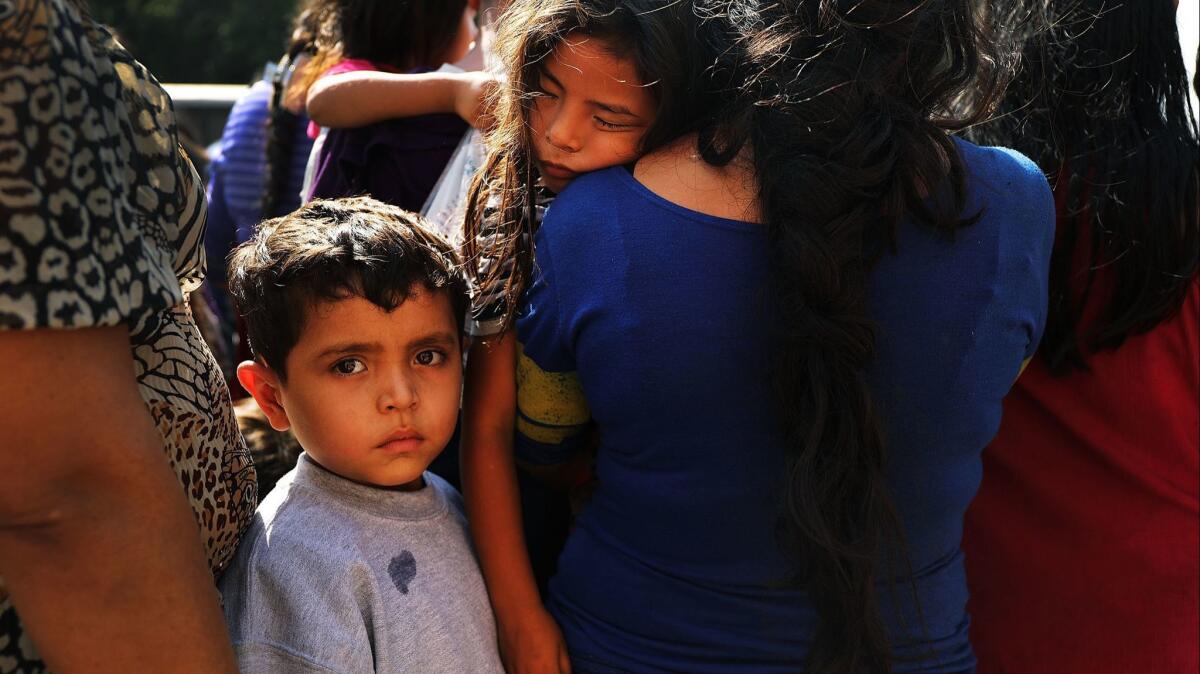Fact check: Trump strays from the truth again and again on immigration

President Trump is distorting the truth when it comes to the impact of his administration’s policy regarding separating children from their parents at the U.S. border.
He falsely suggests that a newly signed executive order will permanently solve the problem of separations by keeping families together when they are detained for illegally crossing the border and exaggerates the number of immigration judges available to process their claims while they’re held in custody. A growing backlog of claims could mean that people will be held longer in detention until their cases are heard.
Here’s a look at some of his statements and the reality behind them:
TRUMP: “And ultimately, we have to have a real border — not judges. Thousands and thousands of judges they want to hire. Who are these people? When we vet a single federal judge, it goes through a big process. Now we’re hiring thousands and thousands.… And it got so crazy that all of these thousands — we now have thousands of judges — border judges — thousands and thousands.” — remarks Tuesday to the National Federation of Independent Business.
TRUMP: “We shouldn’t be hiring judges by the thousands, as our ridiculous immigration laws demand, we should be changing our laws, building the Wall, hire Border Agents and Ice and not let people come into our country based on the legal phrase they are told to say as their password.” — tweet Thursday.
THE FACTS: He’s incorrect about the U.S. having “thousands and thousands” of immigration judges and about thousands of additional judges being hired. The Justice Department’s immigration courts division has about 335 judges currently on staff nationwide, with the budget for 150 additional judges.
Dana Leigh Marks, past president of the National Association of Immigration Judges who also works in the Justice Department’s executive office for immigration review, said funding for immigration courts has increased modestly amid a growing backlog of cases. With a backlog of 700,000, each judge would have to take on more than 2,000 cases apiece to clear the docket.
The figures also don’t take into account a wave of expected retirements that would shrink the ranks of judges. A June 2017 Government Accountability Office report determined that 39% of the immigration judges are now eligible for retirement. Congressional investigators blamed the mounting caseload in part on the slow hiring of immigration judges and said the federal government needed to do a better job to address staffing needs.

♦
TRUMP: “We’re keeping families together, and this will solve that problem.” — remarks Wednesday at signing of order to halt his administration’s policy of separating children from their parents when they are detained illegally crossing the U.S. border.
THE FACTS: It doesn’t solve the problem.
Trump’s executive order will continue his “zero tolerance” policy of criminally prosecuting all adults caught crossing the border illegally, and will now seek to keep families together in detention instead of separating them while their legal cases are heard by the courts.
But a 1997 landmark settlement known as the Flores agreement that generally bars the government from keeping children in immigration detention for more than 20 days remains in place. Trump is seeking to have the settlement overturned, but his Justice Department says the 20-day policy remains in effect until Congress or the courts take action to change that.
That means without further action from Congress or the courts, the Trump administration could be forced to again separate the immigrant children from their parents in three weeks.
♦
TRUMP: “So here are just a few statistics on the human toll of illegal immigration. According to a 2011 government report, the arrests attached to the criminal alien population included an estimated 25,000 people for homicide, 42,000 for robbery, nearly 70,000 for sex offenses, and nearly 15,000 for kidnapping. In Texas alone, within the last seven years, more than a quarter-million criminal aliens have been arrested and charged with over 600,000 criminal offenses. You don’t hear that.”
THE FACTS: Trump is probably working from a 2011 U.S. Government Accountability Office report that looked at arrests, costs and incarcerations of immigrants who were in the U.S. illegally. The statistics he cites are accurate. He doesn’t note that about half of all of the 3 million arrests of the “criminal alien population” in the study were for immigration (529,859), drugs (504,043) or traffic (404,488). And some of the immigration arrests were related to civil violations, not criminal charges. The report didn’t distinguish between the two.
♦
TRUMP: “I always hear that, ‘Oh, no, the population’s safer than the people that live in the country.’ You’ve heard that, fellas, right? You’ve heard that. I hear it so much, and I say, ‘Is that possible?’ The answer is it’s not true. You hear it’s like they’re better people than what we have, than our citizens. It’s not true.”
THE FACTS: Trump is questioning reports that those living in the country illegally commit fewer crimes than people in the population overall. He shouldn’t.
Several studies from social scientists and the libertarian think tank Cato Institute have shown that people here illegally are less likely to commit crime than U.S. citizens, and legal immigrants are even less likely to do so.
A March study by the journal Criminology found “undocumented immigration does not increase violence.”
The study, which looked at the years 1990 through 2014, argues that states with bigger shares of such people have lower crime rates.
A study last year by Robert Adelman, a sociology professor at University of Buffalo, analyzed 40 years of crime data in 200 metropolitan areas and found that immigrants helped lower crime. New York City, for example, has the nation’s largest population of immigrants living in the country illegally — about 500,000 — and last year had only 292 murders among a total population of 8.5 million people. A city murder rate is often used as a benchmark for overall crime because it’s difficult to fudge murder statistics.
And Ruben Rumbaut, a UC Irvine sociology professor, co-authored a recent study that noted crime rates fell sharply from 1990 to 2015 at a time when illegal immigration spiked.
More to Read
Get the L.A. Times Politics newsletter
Deeply reported insights into legislation, politics and policy from Sacramento, Washington and beyond. In your inbox three times per week.
You may occasionally receive promotional content from the Los Angeles Times.






